|
JULY / AUGUST 2006
by Sandy leven
Hot, Sunny and Overseas
Literally.
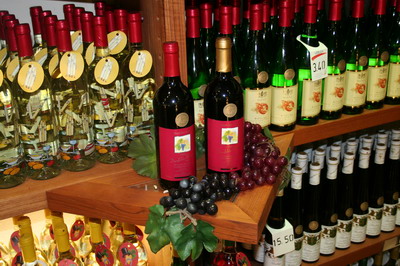
German wine
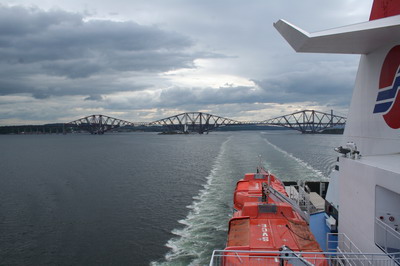
Forth Rail Bridge from the Superfast Ferry
There is no doubt about it! July is our summer holiday time! This year we went caravanning in central Germany.

Our car and caravan on the Ferry
We travelled via Superfast X from Rosyth to Zeebrugge which is just North of Ostende in Belgium. I wrote about the crossing in 'The Rock Garden' when the service started and it is still just as good: if not as frequent. We now have 3 sailings a week instead of the daily sailings of the start up period. The initial 2 ships have been reduced to one, which goes back and forward. How disappointing that in these days of high fuel costs, escalating wage bills and our being bombarded from every side by 'Green Issues' that the people of Scotland [Haulage firms especially] could not find enough stuff to transport to the continent via Rosyth. I understand that it was the reduced traffic in winter that led to the reduction in the service. Hull is a day's drive away, so that crossing takes 2 days out of your holiday. Dover is even further. 1000 miles return from our home - and we would normally stay in a hotel in Ashford on the way down and another North of London on the return. Just how much does that cost in time, effo
rt and money?
Our holiday starts as soon as we drive onto the ship. On board by 4.00pm, find your cabin and get your things organised, up on deck to watch the ropes being cast off [you don't want to miss a thing!]. Before dinner there is time for a wee drinkie in the bar and a sing-along with the on board duo. The crossing takes 17 hours. What does this mean? It means you relax at the beginning and end of your holiday. It means you have an enjoyable evening meal. It means you can get a good night's sleep. It means you have time for your breakfast before you drive off onto the Belgian roads and start your adventures.

The Fife coast with the Lomond Hills [ ancient volcanoes] on the skyline
This crossing is a wonderful way to enter and leave Scotland. With Fife to the north and The Lothians to the south, you quickly appreciate the beauty of the Forth estuary and all the historic towns and villages fronting the sea shore.

Edinburgh, Arthur's Seat, Salisbury Crags [basalt rocks]
The excitement of sailing under the Forth bridges, a train crosses the rail bridge, seeing Edinburgh and its castle from the sea with Arthur's Seat and the Salisbury Crags silhouetted against the sky line, 'Britannia' docked beside Ocean Terminal, watching the gannets from the Bass Rock, comparing Largo Law with the more prominent North Berwick Law, pondering the fortifications on The Isle of May and savouring the sunshine on Inchcolm Abbey and its eponymous island combine to give the traveller a smidgen of Scotland in microcosm.
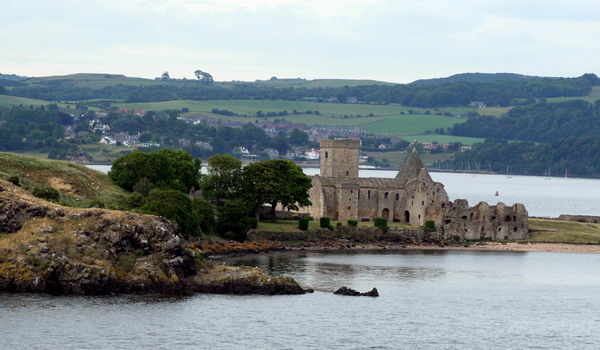
Inchcolm Abbey
The geological features around the Forth Estuary remind us of the violent volcanic processes which formed Eastern Central Scotland and there is enough historical interest to write a PhD. Prehistoric Scotland, Medieval Scotland, Victorian Scotland, Industrial Scotland and Modern Scotland are intricately woven together and I am reminded of just how lucky I am to have been born and raised in such a wonderful part of the world. St Andrews, Dundee and Edinburgh with their botanic gardens are all close by.
A quick toast of 'Here's tae us. Wha's like us? No mony and they're a' deid' springs to mind here.
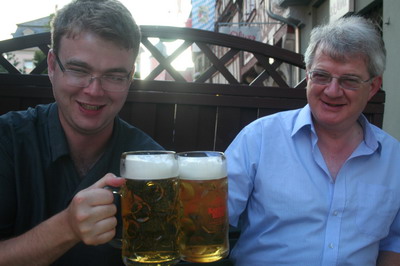
Here's Tae Us! [in Oxenfurt, Bavaria]
I am, in spite of all this, a good European and I delight in travelling, seeing other places and what grows there, meeting other people, eating different things and drinking other beers.
We travelled well away from the sea to our first camp site in the German VulcanEifel region which is South of Cologne and North of the Mosel. Here the local authority, University of Bonn and the Tourist Board have combined their talents to promote the volcanic features of the region. So this part of Germany was formed in a similar way to Eastern Scotland! .
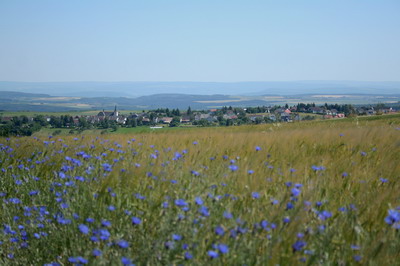
Cornflowers in cornfield with the rolling hills of the Eifel behind
Like southern and central Scotland, it is an extensively farmed landscape of rolling hills, wooded valleys and with many small towns and tidy villages and pretty gardens. Every now and then there is a castle guarding a valley or river crossing. Mandersheid where we stayed had two castles. Mandersheid lies on the border of the historic territories of Trier and Luxemburg and the two castle were built by the opposing states.
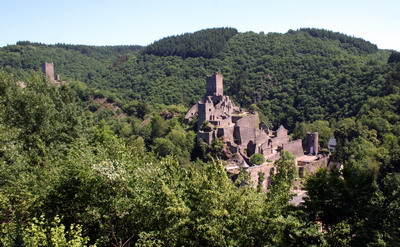
Mandersheid's two castles
We stayed at the Natur-camping Vulcaneifel Feriendorf which is just on the edge of forests outside he town of Mandersheid. There were good walks around the site and within short driving distance were several volcanic features. Red Kites circled in the sky just as they do near Dunblane where they have recently been reintroduced
The most dramatic features were the 'volcanic maars' but there are basalt outcrops as well. The volcanic activity started about 1 million years ago and the most recent volcanic events were only 10 thousand years ago, so more activity is expected in the future. A maar is formed when a volcano erupts, collapses on itself and leaves a circular crater which then fills with water. They are smaller versions of Crater Lake in Oregon. Of the 74 Maars known only 9 now have water in them. The others are filed with bogs and sediment.
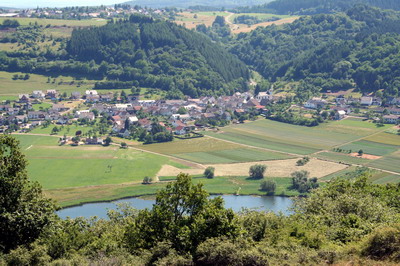
The village of Meerfelder beside Meerfelder Maar
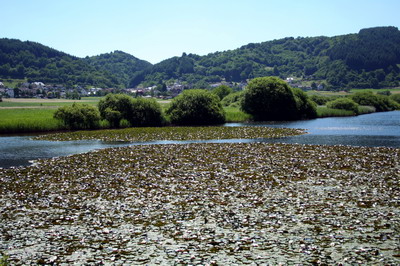
Waterlilies on Meerfelder Maar
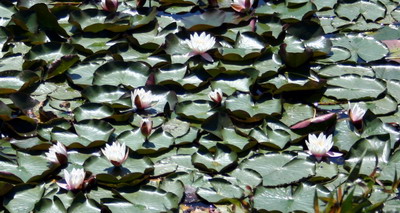
In view of all this volcanism it is not surprising that this area of Germany produces many different brands of bottled mineral water. Our favourite was 'Gerolstein' from the town of the same name.
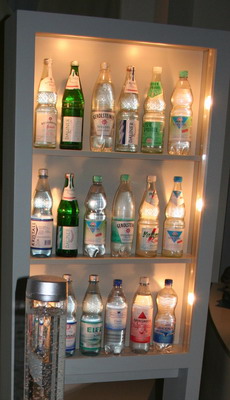
Various mineral waters from the Eifel region of Germany
At Wallenburn there is a geyser on the site of a proposed water bottling plant. The site proved impossible commercially but now every half hour or so the amount of gas dissolved in the water causes it to erupt like a mini Yellowstone [where the water erupts because it is heated]
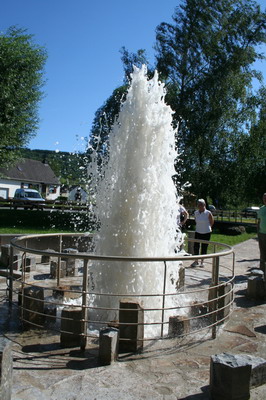
The Wallenburn geyser
There are many similarities between the parts of Germany which we visited an our home. Many of the flowers are of genera which we know. Historically the safe route across the continent which medieval [and later] Scottish travellers would have had to follow went from the Belgian/ Dutch coast along the great rivers towards he Rhine, over the alpine passes and south to the Italian border and on to Rome.
In Mandersheid her was a fine specimen of the dwarf chestnut tree Aesculus pavia [perhaps?] which I had admired at this year's Chelsea Flower show in May.
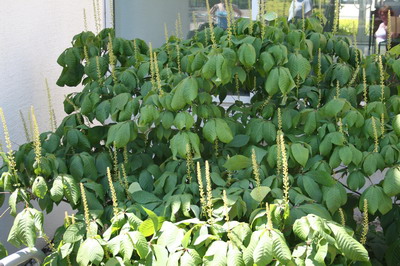
Aesculus
Growing in the wall beside it was a beautiful little Campanula which eth is or is very similar to C.wockii, one of the first alpines I met at Jack Drakes nursery.
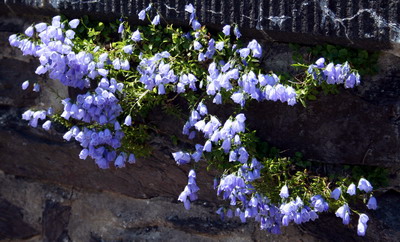
Campanula wockii
We drove for miles along the crater edge of one of the volcanic maars and found many familiar flowers.
A rough leaved Verbascum which I took to be V.blatteria was sometimes single stemmed and sometimes multistemmed. The leaves are a bit course but it had wonderful purple hairy stamens.
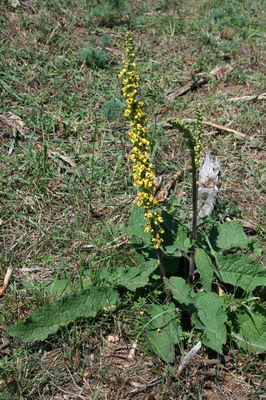
Verbascum blattaria
Ferny, wispy Euphorbia cyparissias spread gently through the rough scrub
Wild mountain couldn't grow among the purple heather because there was no heather at Mandersheid
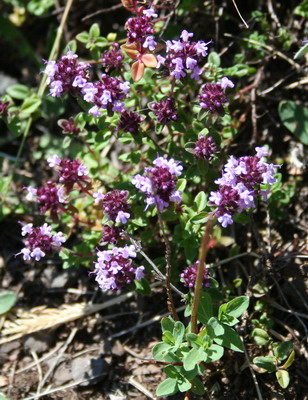
Thymus serpyllum
At one stage the roadside was lined with Viper's bugloss, Echium vulgare. As you can see from the picture it was easy to see many of the flowers without even leaving the car.
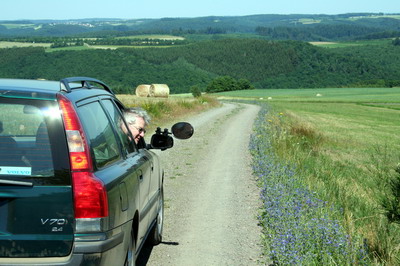
Echium vulgare
In many places the dwarf musk mallow Malva moschata brightened up the road verges
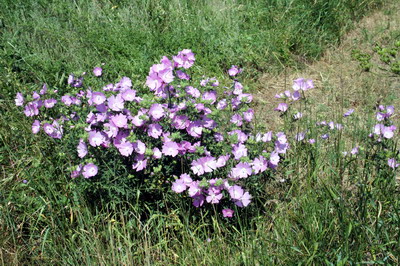
Malva moschata
Under hedgerows in rough long grass by the road sides purple heads of black knapweed, Centaurea nigra brightened the waysides
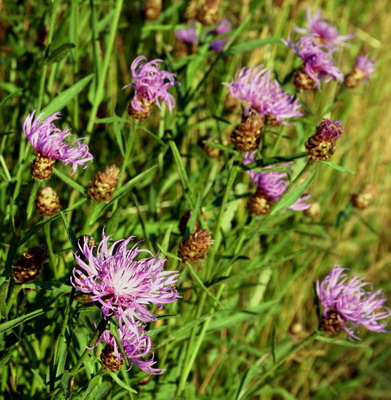
Centaurea nigra
As familiar plants appear to be everywhere it gives you a great feeling to see something familiar but different. Such a plant is Campanula rapunculoides [creeping bellflower apparently is its common name. Since it grows all over Europe except in the UK it is a wonder it even has an English common name!]
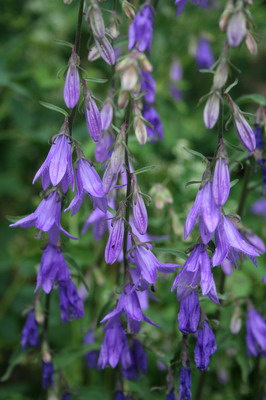
Campanula rapunculoides
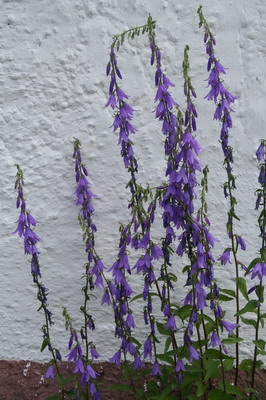
Campanula rapunculoides against a church wall
This is just a taste of our first few days in Germany. So for now its cheerio!
This month started in Pitlochry with wonderful pictures of Flowers of the Dolomites from Michael Almond. I am sorry I did not write this in time to point you towards the exhibition. You can still see some of his images on the 'Monthly Roundup posters, on the display boards in the Douglas Pavilion.
For the rest of August and early September Sue and Michael Thornley's pictures of Magnolias provide a beautiful record of these superb shrubs and trees. Not quite rock plants but like Rhododendron, Magnolias fit in with our scheme of gardening. Michael and Sue's garden at Glenarn near Helensburgh is open daily under Scotland's gardens scheme till 21st September. The garden is world famous - especially for its great collection of Rhododendrons.
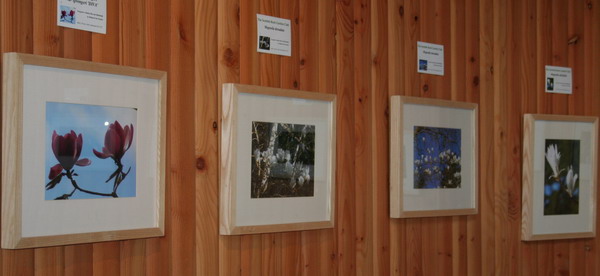
…..and a final message from the continent
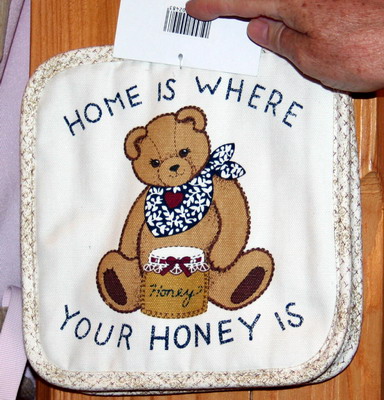
^ back to the top ^
|

